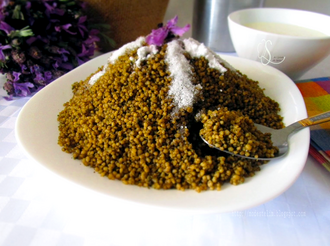Couscous el-Hamama – The Lavender Couscous of Blida
More Than Food, a Heritage

There are dishes you eat, and then there are dishes you inherit. Couscous el-Hamama, or the couscous of the dove, belongs to the second category. It is not simply a meal — it is ancestral medicine, culinary art, and spiritual ritual woven together.
Originating from Blida, a city between the Mitidja plain and the Atlas mountains, this couscous stands apart from all others in Algeria. Subtle yet powerful, sacred yet everyday, it carries memory, intention, and healing in every grain.
The Key Ingredient: Wild Lavender
At the heart of couscous el-Hamama is an unexpected element — fresh wild lavender flowers.
- The blossoms are crushed by hand, releasing a fragrance that feels almost sacred.
- Their juice, diluted with a little water, is used to moisten the semolina.
- Traditionally, the semolina is then hand-rolled, each grain infused with the essence of lavender.
- Finally, it is steamed gently, following the timeless method of couscous preparation.
This process is slow, intentional, and deeply tied to the rhythms of nature.
How It’s Served
Unlike the savory couscous most Algerians know, this dish is sweet, herbal, and delicate.
- Lightly sprinkled with sugar
- Paired with leben (buttermilk), which softens the lavender’s subtle bitterness
The result is a couscous that is bittersweet, airy, and deeply comforting.
The Medicinal Power of Lavender
For generations in Blida, lavender has been valued not only as a flavor but also as a healing herb. Its benefits are widely recognized:
- Aids digestion after heavy meals
- Calms the nervous system, easing stress
- Cleanses the body, acting as a natural purifier
By weaving this plant into food, Blidians preserved both culinary and medicinal traditions at once.
More Than a Recipe, a Memory
Couscous el-Hammama is not just a dish — it is a story. Many recall childhood afternoons when the house was filled with lavender’s aroma, drifting not from gardens but from kitchens, where mothers and grandmothers prepared couscous the old way.
Today, with industrial, pre-rolled couscous so common, few continue to make semolina by hand. Yet the memory of this lavender couscous lingers — a call to preserve a fading tradition that connects body, soul, and heritage.